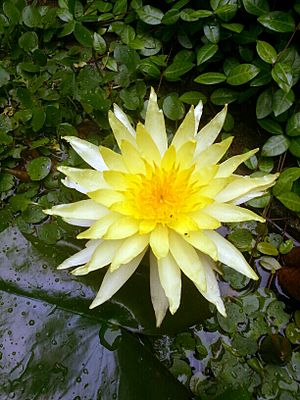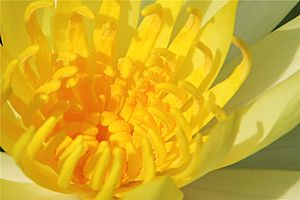Yellow water lily facts for kids
Quick facts for kids Yellow water lily |
|
|---|---|
 |
|
| Scientific classification | |
| Genus: |
Nymphaea
|
| Species: |
mexicana
|
| Synonyms | |
|
Castalia flava (Leitn. ex A.Gray) Greene |
|
The yellow waterlily (Nymphaea mexicana), also called the Mexican waterlily or banana waterlily, is a type of aquatic plant. It grows naturally in the southern United States and Mexico. This plant is well-known for its bright yellow flowers that float on the water.
Sometimes, outside of its natural home, the yellow waterlily can grow too much. It can become a problem plant in places like California. This happens when it is brought to new wetlands or water areas. People sometimes introduce it because its flowers are very pretty.
What the Yellow Waterlily Looks Like
The yellow waterlily has thick roots called rhizomes. It also has long, soft stems that creep along. These stems are called stolons. They have small yellow roots that look like tiny bananas. This is why it is sometimes called the "banana waterlily."
The plant can grow from seeds. It can also send out new shoots from its stolons. Its leaves are large and flat. They are green, often with purple or brown patterns. These leaves float right on top of the water.
The flowers look like floating lotus flowers. They have bright yellow petals. Their green-yellow parts underneath, called sepals, are pointed and star-shaped. The flowers open during the day and close up at night.
Where it Lives and How it Grows
This waterlily blooms mostly in the summer. In warmer places, it can also flower in spring and fall. After flowering, green berries grow underwater. These berries hold the seeds.
The yellow waterlily likes to grow in marshes. It can easily spread into canals and other shallow water areas. Sometimes, it grows so much that it becomes a nuisance.
Animal Visitors
Some animals enjoy eating parts of the yellow waterlily. The canvasback duck (Aythya valisineria) likes to eat the banana-like roots of this plant.


